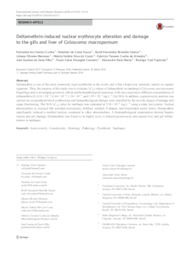Deltamethrin-induced nuclear erythrocyte alteration and damage to the gills and liver of Colossoma macropomum.
Deltamethrin-induced nuclear erythrocyte alteration and damage to the gills and liver of Colossoma macropomum.
Author(s): CUNHA, F. dos S.; SOUSA, N. da C.; SANTOS, R. F. B.; MENESES, J. O.; COUTO, M. V. S. do; SENA FILHO, J. G. de; CARNEIRO, P. C. F.; MARIA, A. N.; FUJIMOTO, R. Y.
Summary: Deltamethrin is one of the most commonly used pyrethroids in the world, and it has a high toxic potential, mainly on aquatic organism. Thus, the purpose of this study was to evaluate LC50 values of deltamethrin on tambaqui (Colossoma macropomum) fingerlings and to investigate genotoxic effects and histopathological responses. Fish were exposed to different concentrations of deltamethrin (0, 6.16?×?10?3; 6.44?×?10?2; 1.34?×?10?1, and 1.93?×?10?1 mg L?1) for 96 h. In addition, a genotoxicity analysis was carried out on peripheral blood erythrocytes and histopathological changes were classified by the severity degree of damage and organ functioning. The 96 h LC50 value for tambaqui was estimated at 5.56?×?10?2 mg L?1 using a static test system. Nuclear abnormalities in exposed fish included micronuclei, blebbed, notched, 8-shaped, and binucleated nuclei forms. Deltamethrin significantly induced a notched nucleus compared to other abnormalities. A histopathological examination showed hepatic lesions and gill damage. Deltamethrin was found to be highly toxic; it induced genotoxicity and caused liver and gill inflammation in tambaqui.
Publication year: 2018
Types of publication: Journal article
Keywords: Alevino, Deltrametrina, Peixe, Tambaqui
Observation
Some of Embrapa's publications are published as ePub files. To read them, use or download one of the following free software options to your computer or mobile device. Android: Google Play Books; IOS: iBooks; Windows and Linux: Calibre.
Access other publications
Access the Agricultural Research Database (BDPA) to consult Embrapa's full library collection and records.
Visit Embrapa Bookstore to purchase books and other publications sold by Embrapa.

